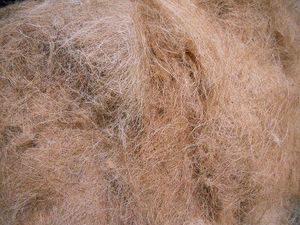
Difference between revisions of "Minnesota Stormwater Manual test page 5"
m |
m |
||
| Line 9: | Line 9: | ||
[[File:Coir fiber.jpg|300px|thumb|alt=image of coir fiber|<font size=3>A close-up view of coir fibre, by [https://commons.wikimedia.org/wiki/User:Fotokannan Fotokannan], licensed under CC CC BY-NC-SA</font size>]] | [[File:Coir fiber.jpg|300px|thumb|alt=image of coir fiber|<font size=3>A close-up view of coir fibre, by [https://commons.wikimedia.org/wiki/User:Fotokannan Fotokannan], licensed under CC CC BY-NC-SA</font size>]] | ||
| − | Coconut (''Cocus nucifera'' L.) pith or coir, the mesocarp of the fruit, is a waste product that has potential benefits in growth media. | + | Coconut (''Cocus nucifera'' L.) pith or coir, the mesocarp of the fruit, is a waste product that has potential benefits in growth media. Coir dust is peat-like and consists of short fibres (< 2 cm). Coir has a large surface area per unit volume, is hydrophilic, and therefore has the ability to absorb water. |
| − | + | There are three basic types of coir material. | |
| + | #Coco pith is a rich, brown color and has a high water retention capacity. | ||
| + | #Coco fibers are stringy bundles that does not readily retain water and will break down over time. | ||
| + | #Coco chips are small chunks of coir that combine the properties of the peat and fiber. Coco chips retain water well and also allow for air pockets. | ||
| − | + | Coir production involves separating the husk from the shelled nut and soaking the husk in water. The fibers are then separated from the pith and the resulting material is screened to create a uniform particle size. A dust is created during this process and the dust may be air dried and packaged. | |
| − | |||
| − | + | Coir benefits may include but are not limited to the following. | |
| − | + | *Coir has a neutral pH | |
| − | + | *Coir improves water holding capacity of soil | |
| − | + | *Coir may improve drainage in fine-textured soils by creating pore spaces as it degrades | |
| − | + | *Coir increases the organic matter content of soil, which can improve soil structure and aggregation | |
| − | + | *Coir production is sustainable and therefore does not contribute to greenhouse gas emissions. | |
| − | * | ||
| − | * | ||
| − | |||
| − | * | ||
| − | * | ||
| − | |||
| − | * | ||
| − | |||
| − | |||
| + | <!-- | ||
==Applications for biochar in stormwater management== | ==Applications for biochar in stormwater management== | ||
Biochar has several potential applications for stormwater management. Below is a brief review of what we know about biochar. | Biochar has several potential applications for stormwater management. Below is a brief review of what we know about biochar. | ||
Revision as of 21:56, 6 February 2020
Coir and applications of coir in stormwater management
Coir
This page provides information on coir. While providing extensive information on coir, there is a section focused specifically on stormwater applications for coir.
Overview and description

Coconut (Cocus nucifera L.) pith or coir, the mesocarp of the fruit, is a waste product that has potential benefits in growth media. Coir dust is peat-like and consists of short fibres (< 2 cm). Coir has a large surface area per unit volume, is hydrophilic, and therefore has the ability to absorb water.
There are three basic types of coir material.
- Coco pith is a rich, brown color and has a high water retention capacity.
- Coco fibers are stringy bundles that does not readily retain water and will break down over time.
- Coco chips are small chunks of coir that combine the properties of the peat and fiber. Coco chips retain water well and also allow for air pockets.
Coir production involves separating the husk from the shelled nut and soaking the husk in water. The fibers are then separated from the pith and the resulting material is screened to create a uniform particle size. A dust is created during this process and the dust may be air dried and packaged.
Coir benefits may include but are not limited to the following.
- Coir has a neutral pH
- Coir improves water holding capacity of soil
- Coir may improve drainage in fine-textured soils by creating pore spaces as it degrades
- Coir increases the organic matter content of soil, which can improve soil structure and aggregation
- Coir production is sustainable and therefore does not contribute to greenhouse gas emissions.